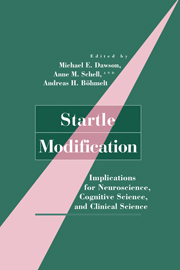Book contents
- Frontmatter
- Contents
- Contributors
- Preface
- Prologue: A Historical Note on the “Discovery” of Startle Modification
- 1 Startle Modification: Introduction and Overview
- PART I BASIC PARADIGMS, METHODS, AND PHENOMENA
- PART II PHYSIOLOGICAL MEDIATION OF STARTLE MODIFICATION
- PART III PSYCHOLOGICAL MEDIATION OF STARTLE MODIFICATION
- PART IV INDIVIDUAL DIFFERENCES AND STARTLE MODIFICATION
- 9 Affective Individual Differences, Psychopathology, and Startle Reflex Modification
- 10 Psychopathic Traits and Intoxicated States: Affective Concomitants and Conceptual Links
- 11 Schizophrenia Spectrum Disorders
- 12 Startle Modification in Children and Developmental Effects
- PART V RELATIONSHIPS WITH OTHER PARADIGMS AND MEASURES
- References
- Author Index
- Subject Index
12 - Startle Modification in Children and Developmental Effects
Published online by Cambridge University Press: 26 March 2010
- Frontmatter
- Contents
- Contributors
- Preface
- Prologue: A Historical Note on the “Discovery” of Startle Modification
- 1 Startle Modification: Introduction and Overview
- PART I BASIC PARADIGMS, METHODS, AND PHENOMENA
- PART II PHYSIOLOGICAL MEDIATION OF STARTLE MODIFICATION
- PART III PSYCHOLOGICAL MEDIATION OF STARTLE MODIFICATION
- PART IV INDIVIDUAL DIFFERENCES AND STARTLE MODIFICATION
- 9 Affective Individual Differences, Psychopathology, and Startle Reflex Modification
- 10 Psychopathic Traits and Intoxicated States: Affective Concomitants and Conceptual Links
- 11 Schizophrenia Spectrum Disorders
- 12 Startle Modification in Children and Developmental Effects
- PART V RELATIONSHIPS WITH OTHER PARADIGMS AND MEASURES
- References
- Author Index
- Subject Index
Summary
ABSTRACT
The development of lead stimulus modification of startle is characterized by increasing inhibitory and decreasing facilitatory modification during the childhood years. Inhibitory lead stimulus modification of startle is particularly weak during a stage of neurophysiological development that involves increased reactivity to stimuli at both cortical and subcortical levels. This neurophysiological stage, occurring during the preschool years, coincides with the Piagetian stage of preoperational behavior. Lead stimulus modification of startle matures during a period of cortical remodeling and other structural brain changes in association with other neurophysiological changes suggestive of the maturation of both cortical and subcortical inhibitory processes. This neurophysiological stage, occurring during the grade-school years, coincides with the Piagetian stage of concrete operations.
In contrast to lead stimulus modification of startle, mature rates of habituation of startle are already achieved during the preschool years. P300 responses to startling stimuli in school-age children show mature lead stimulus modification and habituation, as does the startle response itself. Attentional and affective modification of startle is different in children than in adults, but the direction of differences is inconsistent and requires further study. Autonomic, myogenic, and electroencephalography activity accompanying startle habituation in children do not habituate; heart rate increases as startle habituates, suggesting a state of arousal accompanying startle habituation. These relationships have not been studied in adults.
Development of Startle Modification by Lead Stimulation
Background from Adult Studies
The magnitude of the startle-blink reflex in the human adult can be modified by nonstartling lead stimulation in at least three ways (Graham, 1975; Anthony, 1985).
- Type
- Chapter
- Information
- Startle ModificationImplications for Neuroscience, Cognitive Science, and Clinical Science, pp. 245 - 266Publisher: Cambridge University PressPrint publication year: 1999
- 10
- Cited by

